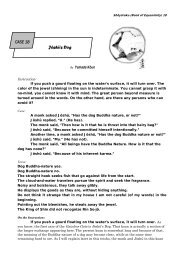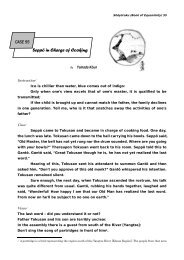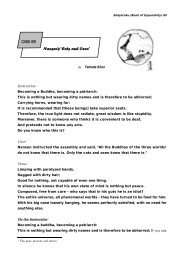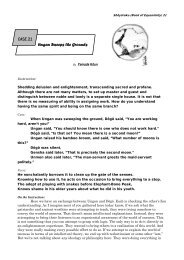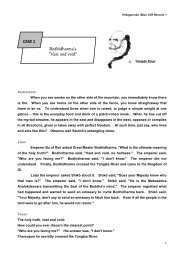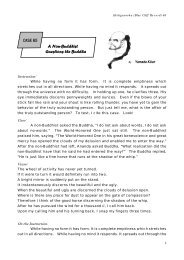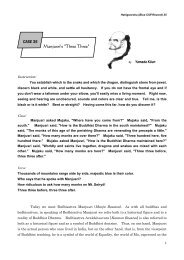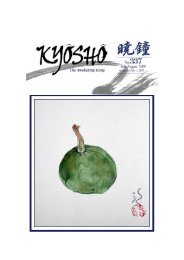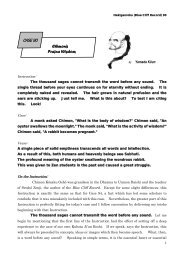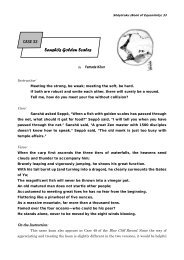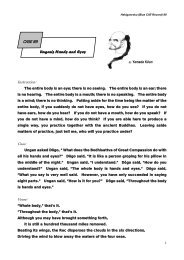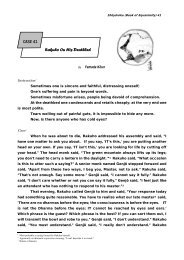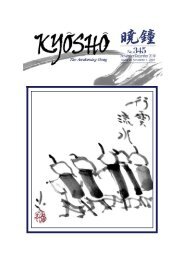Shoyoroku 58
Shoyoroku 58
Shoyoroku 58
Create successful ePaper yourself
Turn your PDF publications into a flip-book with our unique Google optimized e-Paper software.
Shôyôroku (Book of Equanimity) <strong>58</strong><br />
CASE <strong>58</strong><br />
“Getting Despised” in the<br />
Diamond Sutra<br />
By Yamada Kôun<br />
Instruction:<br />
Understanding the meaning depending upon the sutras is the enemy of<br />
the Buddhas of three realms;<br />
Going away one word from the sutras is the same as the devil’s preaching.<br />
The one who is not included in cause and does not go into effect –<br />
Does that person receive karma results or not?<br />
Case:<br />
The Diamond Sutra says, “It is about getting despised by other people: If<br />
you are to come into hell because of your sins in your previous life, these sins will<br />
be extinguished because you are despised by the people of this world.”<br />
Verse:<br />
Merits and faults are continuously connected;<br />
Causes and effects are glued together.<br />
Away from his mirror Ennyadatta runs about crazily,<br />
[Master] Hasôda strikes [the oven] with his staff.<br />
The oven is broken, [the god of the oven] is come to be congratulated;<br />
He sees that he was [always] going against his own self.<br />
On the Instruction:<br />
Recently I traveled to Hawaii for a week’s stay with a particular purpose in mind. The<br />
Hawaii Zendo is under the direction of Aitken Roshi. In his assembly are a number of people<br />
who are quite advanced in their koan study and are approaching the end of that study.<br />
Believing that this is most important matter, when I visited Hawaii last year I promised Aitken<br />
Roshi that I would come again to review koans with some students. I told him that, for students<br />
who had started the Denkôroku (Transmission of Light), I would come in the sense of giving the<br />
final polish to a review of koans. Here in Japan, too, people who have finished study “in the<br />
room” meet twice a year for a koan review session. In the same sense, we had people who were
Shôyôroku (Book of Equanimity) <strong>58</strong><br />
in the final stages of koan study gather for the purpose of koan review. The original plan was to<br />
do it with people in Honolulu and then with people on Maui, but we decided to have people on<br />
Maui come to Honolulu and conduct a two-day review sesshin in Honolulu. I found all the<br />
participants to be quite clear when it came to the content of their realization, which was a<br />
source of relief to me. I am hoping to be able to continue meeting with these people so that we<br />
can at least finish a review up to the Ten Grave Precepts, which come at the end of koan study.<br />
As you know, Zen has flourished considerably in the United States and one of the reasons for<br />
my going to meet with these people is out of concerns about how many reliable teachers there<br />
are in America. These people, not knowing Japanese or Chinese, must unavoidably rely on<br />
English translations of the Zen texts. Most of them can’t read even modern Japanese, and<br />
when it comes to reading the original Chinese texts of the koans, their numbers must be few<br />
indeed. They can only rely on the few Buddhist texts that have been translated in English. To<br />
tell the truth, I feel sorry for these people. People in Japan are fortunate to have translations<br />
that were made centuries ago in China. In the early days of Buddhism and Zen, people brought<br />
back the sutras from India. Outstanding individuals such as Kumarajiva and others received<br />
government assistance in the great project of translating the Indian texts into Chinese. This<br />
resulted in the so-called Tripitaka or collections of sutras. We in Japan are the beneficiaries of<br />
this great virtue. But in the United States, there is no such collection of translations. Even<br />
when it comes to studying the works of Dôgen Zenji, the materials are quite limited. I have no<br />
idea how many people can read the Shôbôgenzô in the original, and in that sense I feel sorry for<br />
these people. On the plane back to Japan I mused on the possibility of translating Buddhist<br />
sutras and original texts into English, much like the Chinese of old, and to contribute those<br />
translations to the United States. If we could make that contribution to the United States, it<br />
would indeed be a contribution to the entire world. I don’t know when such a project will be<br />
possible, but I came back to Japan with that idea in my head. That’s because Zen has developed<br />
in the United States to the point where such a project would be meaningful. I had a chance on<br />
my travels to witness the economic difficulties in the United States that are now being reported<br />
on in the newspapers. President Reagan is trying all sorts of measures to prevent inflation.<br />
Although Hawaii is only one part of the United States, the economic slump is making itself felt<br />
there as well. You get the impression of an ailing giant on witnessing this situation. I felt<br />
keenly my hope that this giant can recover as soon as possible from its illness and become truly<br />
strong. You can consider the above as a short account of my travel impressions. Let me begin<br />
my actual teisho.<br />
Understanding the meaning depending upon the sutras is the enemy of<br />
the Buddhas of three realms; Understanding the meaning depending on the sutras means<br />
reading the sutras and understanding them intellectually. If you consider that to be true<br />
Buddhism, you are like the enemy of the Buddhas of the three realms. The true fact cannot be<br />
grasped in intellectualization, no matter how subtle it may be. The example easiest to<br />
understand is that of the taste of tea. No matter how many explanations I make, I cannot<br />
2
Shôyôroku (Book of Equanimity) <strong>58</strong><br />
convey to another person the taste of the tea I have just drunk. I must have the other person<br />
drink that tea, after which he or she will immediately know. Although you may hear all sorts of<br />
explanations about a variety of tea flavors, you might think you understand but there will<br />
always be doubts remaining. But if you use that as background knowledge in then drinking the<br />
tea for yourself, you will immediately understand. This line is simply saying that it is a great<br />
error to assume that you have understood Buddhism through an intellectual understanding of<br />
the sutras. It is as if you were the enemy of the Buddha. Then comes the opposite statement:<br />
Going away one word from the sutras is the same as the devil’s preaching.<br />
As has been said since times of old, the sutras are the preachings of Shakyamuni<br />
Buddha. They are the meaning and heart of the Buddha. To use the example again of the taste<br />
of tea, you have to taste it yourself, but the sutras are describing that taste exactly. They are<br />
the words of the Buddha. Thus your own experience must be completely one with the<br />
statements in the sutra. After experiencing kensho if you believe that there is any discrepancy<br />
between what is written in the sutras and your own experience, then what you say is “the<br />
devil’s preaching.” So, if you have obtained a true kensho experience, everything that is written<br />
in the sutras will appear. This is the true way. But Zen practitioners tend to push the sutras<br />
aside and concern themselves solely with koans. If there is such a person who does not<br />
recognize the sutras in addition to the koans, this must be said to be the same as the devil’s<br />
preaching. There is the Zen saying kokyô-shôshin, which means reflecting your mind in the<br />
light of the ancient teachings, which of course include the sutras. Having realized<br />
enlightenment, you must reflect on your experience in the light of the teachings, and if there is<br />
anything that you cannot fully accept, it is proof that your experience is still lacking. Among<br />
the teachings of Bodhidharma is the Bloodstream Sermon (Kechimyakuron), which includes<br />
the following line: “The tens and thousands of sutras and sastras only make clear the mind.”<br />
All the sutras are simply a description of the mind. So if you clearly grasp mind, you will be<br />
able to understand everything in the sutras. That text continues: “If you understand it on the<br />
spot, what need is there for doctrines?” This might easily lead to misunderstandings. He is<br />
saying that if you truly realize mind, there is no need for sutras. This is an important point and<br />
it is true if you really realize your own mind. But there is room for doubt about whether the<br />
mind you have imagined to have grasped is the same mind that is spoken of here. It might be a<br />
case of finding a fish’s eye and mistaking it for a pearl! It may be nothing more than a<br />
self-righteous ego trip. In the Zen tradition, any experience must undergo the check of an<br />
authentic master. Many are those who decide on their own that their experience is an authentic<br />
one. But in most cases, like I just mentioned, it’s a matter of mistaking a fish eye for a pearl.<br />
The one who is not included in cause and does not go into effect –<br />
Does that person receive karma results or not? The “one who is not included in<br />
cause and does not go into effect” means a person who is not included in the law of causation. Is<br />
there such a person? Causation remains a matter of the phenomenal world. The myriad<br />
appearances come into existence as a result of the law of causation. But the true self is not<br />
3
Shôyôroku (Book of Equanimity) <strong>58</strong><br />
connected with causation. The reason is because it is empty. Nevertheless, the world of<br />
phenomena and the true self that is not caught in the law of causation are both empty and one.<br />
Seen from one standpoint, we are all at the mercy of causation. For example, when<br />
Shakyamuni Buddha’s time came, he also died. It is said that he died from diarrhea due to a<br />
stomach ailment or something of the sort, although I don’t know what he ate to cause that. But<br />
even the Buddha, if he eats something bad, will become sick. He cannot escape the law of<br />
causation. At the same time, although Shakyamuni Buddha was sick, he also clearly realizes<br />
the standpoint from which he is not sick. This is an important point. This is what is meant by<br />
the one who is not included in cause and does not go into effect. Does such a person receive<br />
karmic retribution or not? For example, does the Buddha receive such karmic retribution? Seen<br />
from one perspective, he certainly does. Seen from another perspective, he absolutely does not.<br />
And this is not only true for Shakyamuni Buddha. It is true for all of us. These final lines of the<br />
Introduction are said while placing its sights on the Main Case, where an example is given. The<br />
Main Case in today’s koan consists of a short passage from a sutra. When it comes to the<br />
Diamond Sutra, I think of Hanamoto Kanzui Roshi of Mokusenji Temple located on Mugasôzan<br />
in Ofuna, where a huge statue of the Bodhisattva Kannon stands. He established his zendo as a<br />
basic training center for study of the Diamond Sutra. The person who first established the<br />
temple passed away a long time ago. His name was Hamaji Tenshô, an attorney by trade. He<br />
himself became a fervent admirer of the Diamond Sutra and engaged in practice and study<br />
concentrating on that sutra for his entire life. He put his private funds into construction of a<br />
dojo. The temple was opened as a temple of the Soto School, with funds from Mr. Hamaji<br />
evidently. The temple was completed when Takashina Rôsen Zenji was the abbot of Eiheiji<br />
Temple. I had a chance to meet with Takashina Roshi when I visited that temple. The word<br />
Mugasôsan, the name of the temple’s location, literally means “no form of an ego.” This can be<br />
expressed by the phrase “subject as zero.” This originally comes from a passage in the Diamond<br />
Sutra which states: No form of an ego, no form of a person, no form of a soul.<br />
As part of their practice, the practitioners shouted “mugasô!” in a loud voice. But no<br />
matter how much you shout that, it will not result in becoming no form of an ego (mugasô). As I<br />
am always saying, if practice were simply a matter of exerting physical force (such as in<br />
shouting), nothing could be easier. But no matter how loud you cry out “mugasô!” it won’t lead<br />
to realization of that egoless self. During my time as a student of Hanamoto Roshi I learned a<br />
great deal about the Diamond Sutra. Recently, when I paid a New Year’s visit on the Roshi, he<br />
was delivering a teisho on the merits of the Diamond Sutra. That’s certainly true. Hanamoto<br />
Roshi originally practiced in a Rinzai Temple. Ueda Shôzan Zenji was himself a Soto monk but<br />
he too practiced under a Rinzai master and received inka shômei before returning to his own<br />
temple. That’s the same as the case of Harada Roshi. At any rate, Hanamoto Roshi originally<br />
studied under Ueda Shôzan Zenji. When I practiced under Hanamoto Roshi, he also gave me<br />
koans to practice with. Lately, however, he speaks ill of koans, and doesn’t think positively<br />
about koan Zen. I told him I felt the same way, and he told me the only real way is with the<br />
4
Shôyôroku (Book of Equanimity) <strong>58</strong><br />
Diamond Sutra. I said I agreed with him but also expressed my view that unless students can<br />
see through the initial “dharma mind” (hosshin) koans, it will be difficult for them to<br />
understand the Diamond Sutra. I also said that, in order to understand the Diamond Sutra<br />
with genuine clarity, there must be an initial opening of the dharma eye. When I visit<br />
Hanamoto Roshi we always get into such discussions. I actually practiced under four different<br />
masters. My last master was Yasutani Roshi, which explains why I am leading this Zen dojo<br />
here today. All of those masters have now passed away, with the exception of Hanamoto Roshi.<br />
For the latest number of Kyôshô I asked Mr. Miyazaki to visit Hanamoto Roshi to have him<br />
write calligraphy to appear as a photograph in the frontispiece.<br />
To return to the topic of the Diamond Sutra, it is the 534 th sutra of the<br />
Mahaprajnaparamita Sutra, which includes 600 texts. The word prajna means wisdom. Before<br />
translating the entire text of the Mahaprajnaparamita Sutra, Kumarajiva, a famous translator<br />
of sutras, made a special translation only of this text, so that it appeared in the Buddhist world<br />
as an independent text. The Diamond Sutra has a very close relationship to Zen Buddhism. In<br />
Buddhism, it would be no exaggeration to say that the Tendai School and Nichiren School were<br />
based on sutras such as the Lotus Sutra and the Lotus Sutra of the Wonderful Law. Meanwhile<br />
the Shingon School is based on Vairocana Buddha, while the Jôdo or Pure Land School is based<br />
on the Amitāyurdhyāna Sūtra and the Nirvana Sutra, having these texts as their basis. In the<br />
case of the Zen school, when it comes to basic texts you could see the Amitāyurdhyāna Sūtra as<br />
representative. And among the texts in that longer work, the Diamond Sutra has a special<br />
relationship to the Zen school. For example, it was a particular passage in the Diamond Sutra<br />
that touched off the enlightenment experience of the Sixth Patriarch Huineng: “Dwelling<br />
nowhere, the mind comes forth.” Let us look now at the words in the Diamond Sutra that<br />
appear as the text of today’s koan.<br />
On the Case:<br />
The Diamond Sutra says, “It is about getting despised by other people: If<br />
you are to come into hell because of your sins in your previous life, these sins will<br />
be extinguished because you are despised by the people of this world.” A person is<br />
despised or belittled by others. This is because he created bad karma by doing something bad in<br />
a previous life. Karma is something that is created with our body, mouth and mind, whether it<br />
be good karma or bad karma. This then definitely develops outward as a result in accordance<br />
with the law of causality. We can say that everything in the phenomenal world develops as a<br />
result of the law of causality. We create the cause that is the root of cause and effect. It can be<br />
created by the body, the mouth or the mind; and this holds true for both good karma and bad<br />
karma. To repeat, this will definitely extend out in the phenomenal world according to the law<br />
of causality. An example of karma created with the body would be murder. Nevertheless, the<br />
source would be the mind in this case. There are many cases of creating karma with the mouth<br />
in speaking out of turn, all of which becomes karma. Then there is karma created with the<br />
5
Shôyôroku (Book of Equanimity) <strong>58</strong><br />
mind or will. Although it does not first appear on the outside, if you harbor feelings of dislike<br />
toward another person in your head and believe no one knows about it, it will nevertheless<br />
appear as an effect. And, as the text says, that karma may cause us to go to hell or to fall into<br />
the path of the hungry spirits, if we create the causes that lead to that particular effect. Let’s<br />
say that you were spoken poorly of by others in a former life. Then you will not have to fall into<br />
a hell, because you were spoken poorly of by others in a former life.<br />
The word “hell” or “evil paths” in the original (akudô) means hell, hungry spirits,<br />
beasts, shura (angry creatures) and humans. What is this text actually referring to?<br />
There have been various interpretations, but I would like to see it from two basic<br />
standpoints. The one standpoint sees this as only treating matters in the phenomenal world.<br />
For example, let’s say you strike a bell so that it rings. Striking the bell is providing a cause.<br />
The result is the sound of the bell. The ringing of the bell is the process by which the cause of<br />
striking gradually disappears. When the sound stops completely, the original cause has<br />
disappeared completely. This is one way of looking at it. If we compare it to waves breaking on<br />
the shore, you could say that there was a cause that resulted in the effect of the wave breaking<br />
on the shore. What is the cause in this case? Probably the wind. Especially in the case of the<br />
ocean, the waves result from the blowing of the wind. The waves breaking on the shore are the<br />
process by which the cause fades and disappears. When the wave breaks and becomes calm<br />
water, the original cause has disappeared. You might assume that everything comes to rest, but<br />
causes are created in succession so that waves continue to break on the shore. But when we<br />
consider it in terms of a single wave, there was a cause that resulted in the wave breaking on<br />
the shore. Masaharu Taniguchi, the founder of Seicho-No-Ie, maintained that illness results<br />
from some cause, which can be seen as karma. Thus, illness is the process by which the karma<br />
disappears. In terms of the phenomenal world, that is a possible explanation. But, as I<br />
mentioned, I would like to propose a second view, which involves looking more closely at our<br />
essential self. Indeed, there is no salvation other than grasping in actual experience that the<br />
self is empty. There is the following passage in the Huayen (Kegon) Sutra:<br />
Should one wish to repent of it, let him sit upright and meditate on the true aspect of<br />
reality. All sins are just as frost and dew, so wisdom’s sun can disperse them.<br />
In Christianity, if you do something wrong, you confess it to the priest and the sin is<br />
forgiven. The position of the Kegon Sutra, however, is that if you think you have done<br />
something wrong, you should by all means sit in zazen and look at your own actual substance.<br />
Your essential nature is completely empty. That means causes are empty and sins are empty.<br />
All is empty. And if you clearly see that, then all sins disappear like frost and dew. The<br />
wisdom’s sun is the wisdom of your own true nature. This is the standpoint I would like to<br />
preach. It is perfectly all right to do penance. But the most thoroughgoing manner is to realize<br />
the essential emptiness of all sins and to see that you are saved in that realization. Thus, if<br />
others abuse you, don’t get angry. Just sit and look at your own true self. If you do so you will<br />
realize that the sin has no content. And then the evil karma that was created in a former life is<br />
6
Shôyôroku (Book of Equanimity) <strong>58</strong><br />
erased. This is how I want to see these words in the sutra. There’s no doubting that the sin will<br />
disappear. Remember the words from the Heart Sutra:<br />
Avalokiteshvara Boddhisattva, practicing deep Prajna Paramita, clearly saw that all<br />
five skandhas are empty, transforming anguish and distress.<br />
When I spoke with Hanamoto Roshi the other day, I only spoke about koans, but<br />
reflecting on the matter now, I feel that prior to the Diamond Sutra we should study and deeply<br />
understand the Heart Sutra. Realizing the emptiness of the five skandhas (Japanese: go-on)<br />
means realizing that the evil karma you have created is completely empty and in that way<br />
escaping all suffering. The Heart Sutra can be seen as the essence of the Mahaprajnaparamita<br />
Sutra, which I mentioned up above. And in deeply understanding the Heart Sutra, you will<br />
clearly understand the Diamond Sutra. The Diamond Sutra uses syllogism (triple-tiered<br />
approach), a kind of logical argument in which one proposition is inferred from two others. An<br />
example is the following: Rain is not rain, therefore it is called rain. A man is not a man,<br />
therefore it is called a man.<br />
Using the approach of the Diamond Sutra, we can say that sin is the numerator of my<br />
fraction. “Sin is not sin” is the denominator. “Therefore it is called sin” is the fraction itself. To<br />
give another example, “a pillar is not a pillar” is the seen from the world of the denominator,<br />
which is completely empty. But seen from the aspect of the entire fraction, “therefore it is called<br />
a pillar.” I can do it for myself as well. “Yamada is not Yamada. Therefore he is called Yamada.”<br />
If someone asks me my name, I say, “My name is Yamada.” But how about from the essential<br />
viewpoint? “I am not Yamada.” This is the method used in the Diamond Sutra. The most<br />
important aspect is that of the denominator. Unless you clearly realize emptiness, you will not<br />
really understand the syllogism in the Diamond Sutra. You have to realize the world of empty<br />
oneness. That’s my reason for saying that, if you truly understand the Heart Sutra, the<br />
Diamond Sutra will also be clear to you. All koans are viewing things from the standpoint of<br />
the denominator. Unless you practice with koans and come to clarity, I said to Hanamoto Roshi,<br />
you will not really understand the Diamond Sutra upon reading it.<br />
On the Verse:<br />
Merits and faults are continuously connected;<br />
Causes and effects are glued together. The “merits” mentioned here are the<br />
merits of prajna wisdom. And that prajna wisdom is clearly realizing that the five skandhas<br />
are empty and thus passing beyond all suffering. The “faults” means the causes. Let us return<br />
to the case just mentioned: If you are made a fool of by others, and have created causes that<br />
would cause you to fall into hell. This is referring to the phenomenal world. The word<br />
“continuously connected” means that they are stuck together. In other words, merits and faults<br />
are one. To repeat, “merit” means realizing the world of emptiness. “Fault” means the effects of<br />
doing something bad in the phenomenal world. Nevertheless, merit and fault are intrinsically<br />
one. This is the same as “form is emptiness, emptiness is form.” And, as the second line says,<br />
7
Shôyôroku (Book of Equanimity) <strong>58</strong><br />
“causes and effects are glued together.” That means causes and effects are one. This is the same<br />
as the line from Hakuin Zenji’s Song of Zazen: The oneness of cause and effect is clear (inga<br />
ichinyo no mon hirake). If, however, you think that there is the essential world and something<br />
called essential nature that somehow become one, you are gravely in error. They are one from<br />
the very beginning. Let’s assume, for example, that I become ill and have to take to my bed.<br />
The cause of the illness and the effect have become one in that lying in the bed. But it’s not that<br />
the cause and effect are two. They are there in each second. Another example would be<br />
becoming rich or becoming poor. The present balance of your savings is the cause from the past<br />
and the effect, which appears as a sum in or savings account book, although of course there are<br />
people without such a sum. This is also a case of cause and effect as one, but the content of<br />
cause and effect is empty. And because they are both empty, they are one. Unless you are clear<br />
on this, you cannot be saved. You will always feel as though you are tied up with a rope and not<br />
free. But, as the verse says, causes and effects are glued together; they are one. The most<br />
important thing is realizing that they are empty.<br />
Away from his mirror Ennyadatta runs about crazily, Most of you are familiar<br />
with the story of Ennyadatta, who is sometimes portrayed as a woman and sometimes as a<br />
man, although one doesn’t know for sure which is true. Every day Ennyadatta enjoyed looking<br />
at his handsome face in the mirror. One day, however, when he looked in the mirror he didn’t<br />
see his head. Why that happened, he didn’t know. Yasutani Roshi says that the mirror might<br />
have been turned around! At any rate, he couldn’t see his head and started running around<br />
crying, “someone has stolen my head!” His friends, thinking he was mad and feeling sorry for<br />
him, caught him and tied him to a tree. When he had settled down a little, one of his friends<br />
slapped him. Crying out in pain, he inadvertently felt his own head and said, “I have a head!”<br />
Once again, he started running around the town, madly crying, “I have a head, I have a head!”<br />
Yasutani Roshi says the part of the story where his friends tie him to a tree is symbolic of how<br />
we fold our hands and legs in zazen. We suffer under the delusion that our true self is outside of<br />
us and run after it. This is the source of all suffering. When we realize that our true self is right<br />
here, we realize great peace of mind. After all, when the content is empty, there’s nothing to<br />
argue about.<br />
[Master] Hasôda strikes [the oven] with his staff. There’s a story behind this<br />
line as well. Once there was the mountain Sûzan which had a small shrine with an oven where<br />
the mountain deity was worshiped. However, out of fears that the mountain deity would harm<br />
the inhabitants of the village, they offered sheep and chickens in the oven to the god. But there<br />
was a monk who struck the little shrine three times with his staff and said, “This oven is<br />
composed of mud and brick—where does the holiness come from, where does the spirit arise,<br />
that you burn living creatures?” This is pointing to how the content is empty.<br />
Then he hit the oven three times again, whereupon it fell apart. To say “where does the<br />
holiness come from, where does the spirit arise” means that the content is empty. That evening,<br />
a man appeared wearing a blue robe and a crown. He said, “I was originally the spirit of the<br />
8
Shôyôroku (Book of Equanimity) <strong>58</strong><br />
shrine. For a long time I have been subject to the consequences of karma; today, having heard<br />
your explanation of birthlessness, I am free from this place and born in heaven. I just came to<br />
offer thanks.” To speak of “birthlessness” is to realize that it is empty. This is what this line of<br />
the verse is referring to. The name Hasôda means “oven breaker,” referring to how he hit the<br />
oven three times, causing it to collapse. But what is the oven? It is our concepts and thoughts.<br />
The oven is broken, [the god of the oven] is come to be congratulated;<br />
He sees that he was [always] going against his own self. The oven god is<br />
overjoyed on being set free. He realizes that he was in opposition to his own self. Now he has<br />
realized his true self. The concepts have fallen away, just like the oven collapsing, and he has<br />
become truly free.<br />
The koan itself is not difficult, but the verses in the Book of Equanimity are filled with<br />
references to old stories or events, making them difficult to understand. Harada Roshi felt that<br />
way and preferred the Blue Cliff Record for that reason, I have heard.<br />
9



